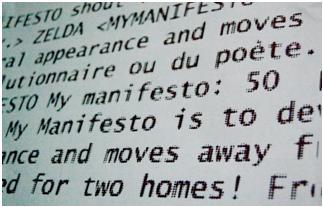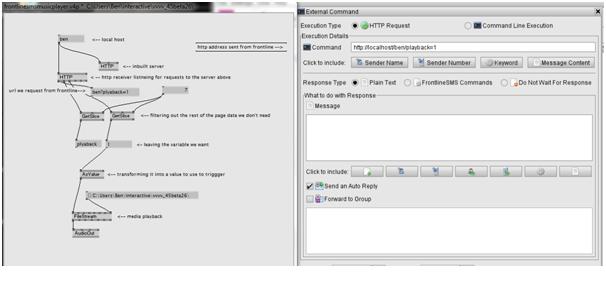I’ve been volunteering with the FrontlineSMS:Radio project and recently had the pleasure of speaking with Colin Spurway of BBC Media Action, an organization which helps people around the world to harness the media to promote change in their communities. Colin is the Project Director of Loy9(pronounced ‘Loy Pram-booun’), a multimedia initiative in Cambodia geared towards encouraging youth participation in civic life through the use of a television series, phone-in radio shows, online discussions and roadshows. We had a great discussion about the significance of the Loy9 initiative in promoting youth engagement in civic society through mobile technology, as well as some of the challenges.
FrontlineSMS used for Inclusive Arts Project in UK
FrontlineSMS really is used all across the world. It is not only used in economically developing countries, but can be used as a tool to connect people in many different contexts. An example of this is the use of our software by interactive arts trio, Invisible Flock. Here Ben Eaton, lead creative at Invisible Flock discusses the way FrontlineSMS is used:

Here at Invisible Flock we make large scale interactive work that ranges from public art, to games, to digital work. We are based in the UK, and at the heart of all that we do is the desire to empower our audiences through participation.
In a way it feels peculiar to be using a platform that is designed and well-documented in its use for some very serious real world applications, however FrontlineSMS has quickly become a central tool in our work.
The reasons we use SMS messages as a platform are, from a design perspective, likely not that different from why the other organisations and NGOs employ them. Our work seeks to engage our participants in a direct and intimate manner, allowing them interactions outside of the traditional space and time of art consumption. This means you don’t have to be in a gallery on a Friday evening for you to take part in the work we create. Using SMS permits us to interweave what we do into the daily lives of our participants in a manner that is both very personal and unobtrusive.
We have been using FrontlineSMS for a year or so and very heavily in the last four to five months. In our most recent piece entitled Your Government Has Gone To Sleep (YGHGTS), we waged a game of revolution in the Chapeltown area of UK city Leeds. We invited residents to sign up to our game and, over the course of a week, we allowed them to become part of a revolutionary movement orchestrated by text message—in which they communicated with each other and took part in a series of small acts of peaceful revolution that re-examined the makeup of that community.
FrontlineSMS enabled us to quickly and easily create a reactive platform to manage and filter our conversations with players in our game. We are always conscious, working in the field of interactive art, of the risk of exclusion due to a potential player’s inability to access the technology, and, as such, we shy away from using smart phones and platforms that are likely to actively isolate. SMS messaging is ubiquitous and cheap and, as such, presents an easy manner for players to enter into our games and for them to continue with it.
We create interaction with FrontlineSMS by making heavy use of the keyword function, grouping participants into subgroups that represent either their progression in a piece’s story or their response to specific questions of tasks. We allocate codenames to players that also serve as keywords that allow our FrontlineSMS setup to serve as a hub for players to communicate with each other whilst still remaining anonymous.
Perhaps most interestingly for us however is the integration of HTTP trigger commands into FrontlineSMS, as it enables us to create complex interactive responses to participants messages. In YGHGTS, we used the keyword MANIFESTO to enable participants to input their own political manifestos to a website which updated every few seconds—allowing them to submit content and see it appear almost instantly on the monitor in front of them. The beauty of FrontlineSMS is that with a keyword, an HTTP command, a simple five-line PHP script and a MySQL database at the other end, we can quickly set up an effective interactive environment.
The ability to use SMS messages to communicate out from FrontlineSMS to a wide variety of applications including physical objects in the real world makes it an invaluable platform in our work. In the next few weeks, we are creating a series of autonomous interactive explorations of the city of Bradford. We are using text messages to trigger and orchestrate journeys that take participants to multiple locations, receive phone calls and trigger events in the real world.
We use a software platform called VVVV to run our complicated multimedia environments and we use the inbuilt HTTP command capabilities of FrontlineSMS to integrate VVVV perfectly. Above is an image showing the simplest setup, using a HTTP command sent from FrontlineSMS to VVVV to trigger playback of an audio file. The same process can then be reversed to control responses and trigger SMS messages from events monitored in the real world by the computer or hardware platforms such as Arduinos.
With this setup, FrontlineSMS becomes almost infinitely extendable, and surpasses its own inbuilt capabilities. We are currently gearing up to launch a series of interactive journeys across a UK city, which will be our most ambitious project involving FrontlineSMS to date. At the height of the experience we are creating participants will be able to trigger content on a city centre big screen by sending a text message — a very real physical impact from a simple SMS, and all run through FrontlineSMS.
- - -
Here at FrontlineSMS look forward to staying in touch with the Invisible Flock team as they continue to use FrontlineSMS in new and exciting ways! To find out more about Invisible Flock’s work visit www.invisibleflock.co.uk. You can also watch a video about some of their recent work here.



